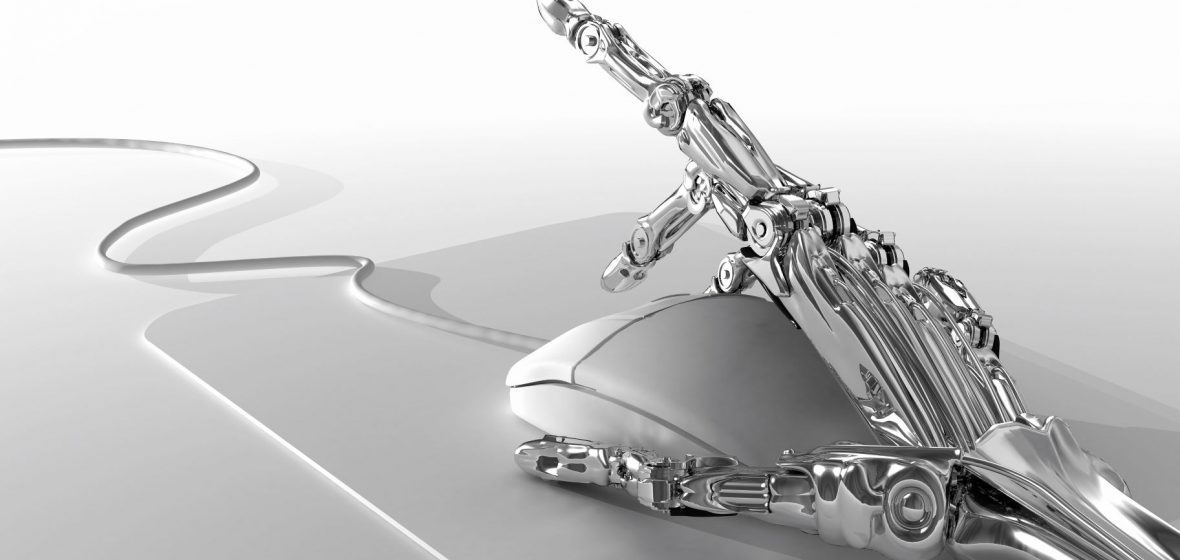With computers increasingly able to predict the outcome of cases and coders creating contracts that execute themselves, lawyers need to act now to future-proof their employment.
“My mind and my time are my merchandise.”
Sound familiar? It’s a mantra that’s been drummed into many a law student. And it’s a mantra in need of a makeover, for, even now, your mind is being emulated – even superseded – by brilliant machines. And your billable time is vanishing as procedural matters are executed in seconds.
In 2014, the Committee for Economic Development of Australia (CEDA) predicted that 40 per cent of jobs would be lost in the next 15 years due to technological advances.
“Lawyers came in at middle risk when assessed on the tasks they do and the number of lawyers that will be needed in the future,” says Professor Stephen Martin, a CEDA director. While
there are gloomy predictions about reduced demand for lawyers in an already over-supplied market, there’s still scope for optimism.
“I say it’s a fantastic time to be a young lawyer if you are prepared to be flexible, multi-skill and are willing to go down an alternative route,” says Dominic Woolrych, Head of Legal at LawPath.
In his first few years as a new graduate in a top-tier law firm, Woolrych, now 30, spent much of his time wondering, “Why are we doing it like this?”
“I knew there was a better way to do things,” says Woolrych. “There were many inefficiencies with the client’s time and therefore the client’s money. I remember billing 10 hours for a letter I knew the client could do themselves if they simply had the tools.”
Woolrych bided his time, waiting for “the shift”. In 2014, he jumped – right into the start-up company LawPath, an online legal platform that relies heavily on automation to make legal services accessible to small and medium-sized businesses. Two non-lawyers, Damien Andreasen and “start-up scientist” Phil Morle, founded LawPath.
“Disruption always comes from people outside the profession as they aren’t restrained by thinking you can’t do something that goes against conventions. Instead they ask, ‘Why not?’” says Woolrych, who won the 2015 Australian Legal Innovation index for his work on LawPath’s Legal Health Check, where a “robo-lawyer” analyses your business’ legal gaps. LawPath boasts 20,000 users and is just one of a number of new law firms that are pulling the rug out from “business as usual” and dismantling an information monopoly by giving away free information, ditching time-based charging for value-based charging, and outsourcing work to lean-operating lawyers located anywhere in Australia, even internationally.
Industry disruption is already taking place in Australia, but we haven’t seen anything yet, according to legal futurist Nick Abrahams, who says that in the next five years law will change more than it has in the past 50.
You’ll be paid in the future based on how well you work with robots.
KEVIN KELLY, futurist
Automation, artificial intelligence, and cloud-based software will be key elements driving the transformation. The areas of law most prone to automation include high-volume areas such as insurance claims, or procedural matters such as wills, conveyancing and leases, according to Abrahams. In these kinds of areas, lawyers won’t do the hands-on work, but will do the thinking about the precedents that go into the automation systems.
At Colin Biggers & Paisley, lawyers are doing just that – working with in-house software developers to create e-contracts that should delight property developers, as they help secure buyer commitment fast.
“In high-volume conveyancing projects where the e-contract system is used, the time we spend and expense we incur in preparing and arranging entry into contracts have been reduced by 80 to 90 per cent,” says CBP property partner Mark Morgan. One of the e-contract features is DocuSign, a digital transaction management technology that allows contract parties to read and sign contracts on almost any internet device, anywhere in the world. At the top end of legal technology is artificial intelligence (AI) where brilliant machines emulate, and even supersede, the human brain’s capacity for analysis.
Based in the Silicon Valley, US company Lex Machina has created a Legal Analytics® Platform that brings big data to the finger tips of lawyers. It draws on huge data banks that contain all case law in the US, together with data relating to factors such as a judge’s particular bias, or the litigation experience of an opposing counsel. Legal clients, lawyers and even judges subscribe to the platform to help them craft a winning case, study the opposing counsel, or predict the likelihood of winning a case.
In the next five years law will change more than it has in the past 50.
NICK ABRAHAMS, futurist
Lex Machina is said to be predicting the results of Supreme Court cases with 70 per cent accuracy. This percentage is likely to rise as machines learn from each “experience” and therefore get smarter as they age. It’s enough to send a shiver down the spine of even the most accomplished lawyers.
Rather than live in fear of computers taking over your job, it’s far better to adopt an attitude of “together we do better” and embrace Intelligence Augmentation (IA).
IA is the new frontier where knowledge workers collaborate with machines to do things that neither could do well on their own. This will require experts to have a solid understanding of what these smart machines can and can’t do in order to know how to balance machine-generated recommendations with human judgment, suggests Daniel Dennett, Director of the Centre for Cognitive Studies at Tufts University, in a 2015 Harvard Business Review blog.
You don’t have to be involved with the high end of legal technology to benefit from the digital revolution. Everyday efficiency can be enhanced enormously by using tools that already exist.
“Efficiency is the name of the game,” says Sydney-based partner of McCullough Robertson Lawyers Alex Hutchens. “We use technology every day to operate more efficiently and thereby lower our hourly rate.”
As well as embracing communication technology to enable collaboration across three different offices, the firm relies on Saas (software as a service solutions).
“Rather than buy our own software, we use cloud-based solutions for back-of-office functions such as expense claim reconciliations. We also have macros for Word and Outlook that automate features and build-in additional functionality, making them much more powerful for jobs such as document mergers, production and comparison,” says Hutchens.
Lynda Gratton, author of The Shift and Professor of Management Practice at London Business School, who contributed to CEDA’s 2015 report Australia’s Future Workforce? says there are two big shifts professionals need to embrace to be ready for the future. The first is hyper-specialisation. If you remain a generalist, your competition will be Google, Wikipedia or a free legal online platform. If you don’t become highly specialised, you’ll need to become highly commoditised, adds Woolrych, making small margins on a high volume of standardised work that is automatable.
The second shift is to focus on collaborating rather than competing. Build value by combining your best ideas with others’, says Gratton. Woolrych agrees: “Learning to work with other disciplines, rather than remaining a closed guild, is key.”
With continuous change becoming the norm, lawyers will need to take more responsibility for their own education and skill development. Investments in areas such as technology, marketing and intellectual property are likely to pay off. Students can take subjects such as “Law Apps” now offered by the University of Melbourne.
One thing computers won’t replace is the human touch. “In professions such as medicine and law, people go to see doctors and lawyers at challenging times of their lives when they prefer the comfort of a human being to a computer,” says Dunstan De Souza, managing partner of Colin Biggers & Paisley. “Two things a human lawyer can bring that machines can’t are judgment calls and building relationships. Even in mundane matters like conveyancing, a phone call at the right time can make all the difference.”
Alex Hutchens agrees that computers won’t displace lawyers, but help them focus on what’s most important – the hard thinking and the relationship with the client. “I use technology to provide a great service and my clients come back to me because we have a great relationship.”
Acknowledgements: Professor Thomas Davenport from MIT Centre for Digital Business (Massachusetts), Lynda Gratton, Dominic Woolrych.
7 WAYS TO PREPARE FOR THE FUTURE
1 Look out for increasing use of digital signatures, now recognised as legally binding in Australia, and smart contracts where the contract is coded then self-executes as it takes in data in real time from external feeds, when certain conditions have been met (e.g. a will could be executed when it registers the person’s death on Births, Deaths and Marriages).
2 Embrace technology: You don’t need to learn to code but you do need to know what tools are available and be open to using them.
3 Take responsibility for your own continuous up-skilling: Consider business and marketing skills as well as professional skills.
4 Specialise: Find a specialty within your profession and head for higher intellectual ground.
5 Develop skills that will complement computers: Interpersonal negotiation, creative problem solving, out-of-the box thinking and emotional intelligence combine well with the cognitive functions that technology can perform.
6 Learn how to work alongside computers: Understand how automation or AI work so you can step in to monitor or modify a computer’s output to make sure it is sound, or to adjust for special cases.
7 Build your collaboration capability: This is essential for lawyers operating in an increasingly global, inter-disciplinary, technologically-enhanced legal delivery system.


 Thea O’Connor is a health and business freelance writer, health coach and presenter, specialising in creating sustainable, healthy work habits and norms.
Thea O’Connor is a health and business freelance writer, health coach and presenter, specialising in creating sustainable, healthy work habits and norms. 

